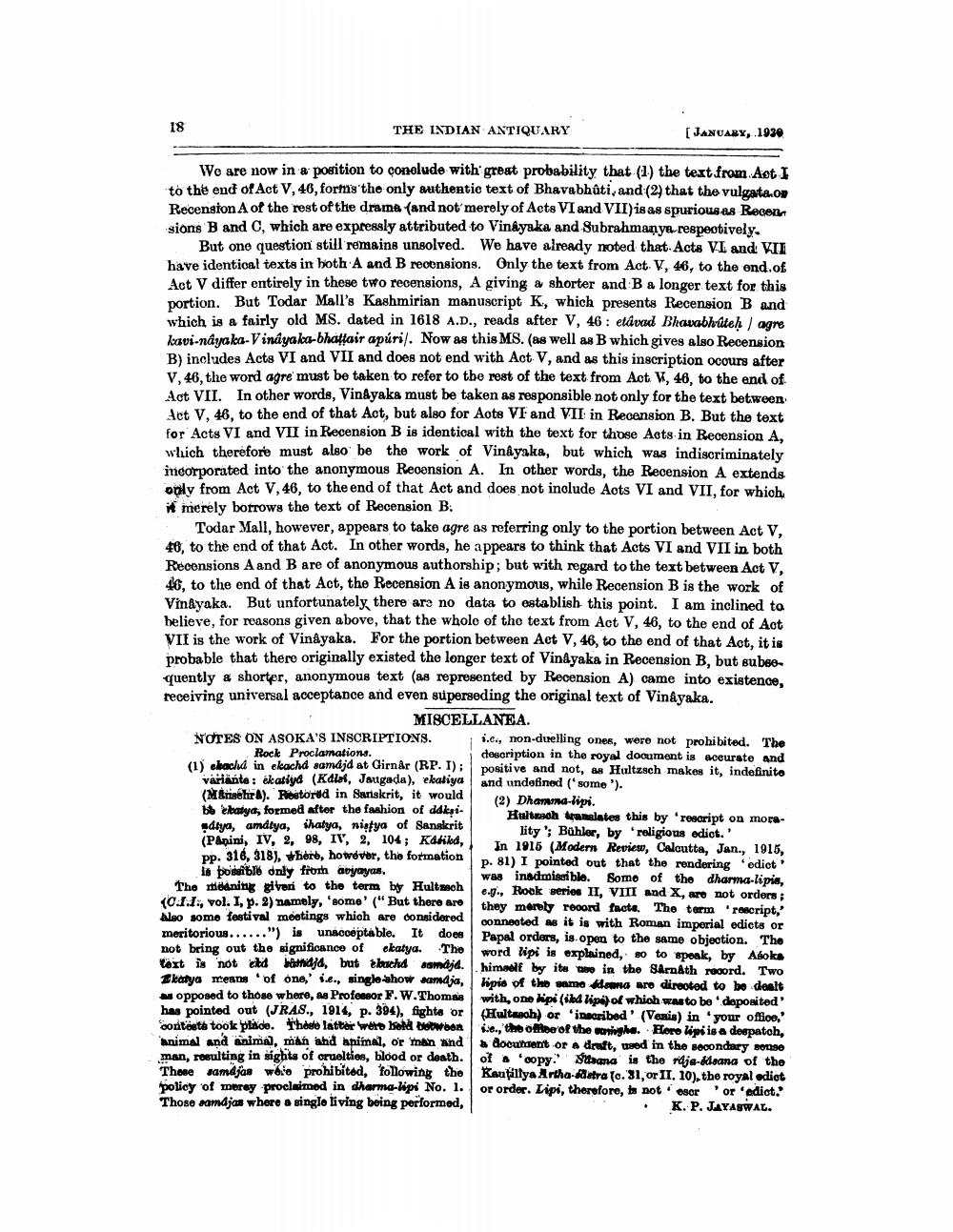________________
18
THE INDIAN ANTIQUARY
[ JANUARY, 1930
We are now in a position to conclude with great probability that (1) the text from Act I to the end of Act V, 46, forms the only authentic text of Bhavabhûti, and (2) that the vulgata.on Recension A of the rest of the drama (and not merely of Acts VI and VII) is as spurious as Recen sions B and C, which are expressly attributed to Vinayaka and Subrahmanya respectively.
But one question still remains unsolved. We have already noted that Acts VI and VII have identical texts in both A and B recensions. Only the text from Act. V, 46, to the end.of Act V differ entirely in these two recensions, A giving a shorter and B a longer text for this portion. But Todar Mall's Kashmirian manuscript K, which presents Recension B and which is a fairly old MS. dated in 1618 A.D., reads after V, 46: etavad Bhavabhuteḥ agre kavi-nayaka-Vinayaka-bhattair apúri/. Now as this MS. (as well as B which gives also Recension B) includes Acts VI and VII and does not end with Act V, and as this inscription occurs after V, 46, the word agre must be taken to refer to the rest of the text from Act V, 46, to the end of Act VII. In other words, Vinayaka must be taken as responsible not only for the text between Act V, 46, to the end of that Act, but also for Acts VI and VII in Recension B. But the text for Acts VI and VII in Recension B is identical with the text for those Acts in Recension A, which therefore must also be the work of Vinayaka, but which was indiscriminately incorporated into the anonymous Recension A. In other words, the Recension A extends only from Act V, 46, to the end of that Act and does not include Acts VI and VII, for which if merely borrows the text of Recension B..
Todar Mall, however, appears to take agre as referring only to the portion between Act V, 46, to the end of that Act. In other words, he appears to think that Acts VI and VII in both Recensions A and B are of anonymous authorship; but with regard to the text between Act V, 46, to the end of that Act, the Recension A is anonymous, while Recension B is the work of Vinayaka. But unfortunately there are no data to establish this point. I am inclined to believe, for reasons given above, that the whole of the text from Act V, 46, to the end of Act VII is the work of Vinayaka. For the portion between Act V, 46, to the end of that Act, it is probable that there originally existed the longer text of Vinayaka in Recension B, but subsequently a shorter, anonymous text (as represented by Recension A) came into existence, receiving universal acceptance and even superseding the original text of Vinayaka.
MISCELLANEA.
NOTES ON ASOKA'S INSCRIPTIONS. Rock Proclamations.
(1) akachd in ekachd samajd at Girnår (RP. I); variante: ekatiyd (Kdies, Jaugada), ekatiya (Mansehr&). Restored in Sanskrit, it would bb elatya, formed after the fashion of dákṣidiya, amátya, ihatya, nistya of Sanskrit (Panini, IV, 2, 98, IV, 2, 104; Kábiká, pp. 316, 318), where, however, the formation is possible only from avyayas. The meaning given to the term by Hultzsch (C.1.1., vol. I, p. 2) namely, 'some' (" But there are Also some festival meetings which are considered meritorious......") is unacceptable. It does not bring out the significance of ekatya. The text is not end bad, but eluchá samajd. Ekatya means of one,' ie., single-show samaja, as opposed to those where, as Professor F. W.Thomas has pointed out (JRAS., 1914, p. 394), fights or contests took place. These latter were held between animal and animal, man and animal, or man and man, resulting in sights of cruelties, blood or death. These samajas were prohibited, following the policy of merey proclaimed in dharma-lipi No. 1. Those samajas where a single living being performed,
i.c., non-duelling ones, were not prohibited. The description in the royal document is accurate and positive and not, as Hultzsch makes it, indefinite and undefined ('some').
(2) Dhamma-lipi.
Hultesch translates this by 'rescript on morality'; Bühler, by 'religious edict.'
In 1915 (Modern Review, Calcutta, Jan., 1915, p. 81) I pointed out that the rendering 'edict' was inadmissible. Some of the dharma-lipin, e.g., Rock series II, VIII and X, are not orders; they merely record facts. The term 'rescript,' connected as it is with Roman imperial edicts or Papal orders, is open to the same objection. The word lipi is explained, so to speak, by Asoka himself by its use in the Sarnath record. Two lipis of the same denna are directed to be dealt with, one lipi (ikd lips) of which was to be 'deposited' (Hultasoh) or 'inscribed' (Venis) in your office," ie., the office of the songhe. Here lipi is a despatch, a document or a draft, used in the secondary sense of a 'copy. Sasana is the raja-deana of the Kaufillya Artha-stra (c. 31, or II. 10), the royal edict or order. Lipi, therefore, is not
"
escr or 'edict.'
K. P. JAYASWAL.




